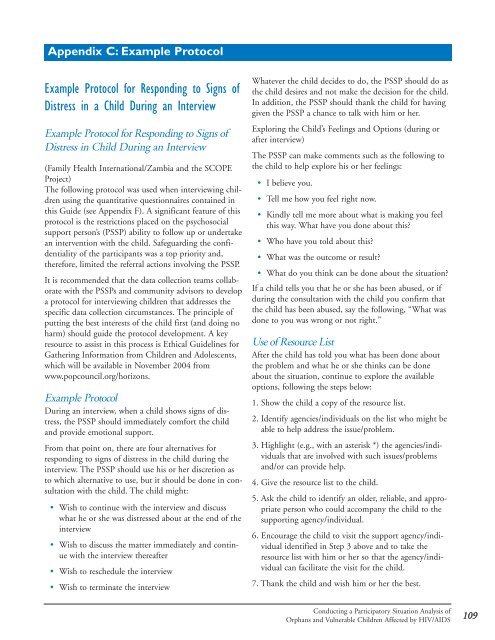Conducting a Participatory Situation Analysis of.pdf - Global HIV ...
Conducting a Participatory Situation Analysis of.pdf - Global HIV ...
Conducting a Participatory Situation Analysis of.pdf - Global HIV ...
You also want an ePaper? Increase the reach of your titles
YUMPU automatically turns print PDFs into web optimized ePapers that Google loves.
Appendix C: Example Protocol<br />
Example Protocol for Responding to Signs <strong>of</strong><br />
Distress in a Child During an Interview<br />
Example Protocol for Responding to Signs <strong>of</strong><br />
Distress in Child During an Interview<br />
(Family Health International/Zambia and the SCOPE<br />
Project)<br />
The following protocol was used when interviewing children<br />
using the quantitative questionnaires contained in<br />
this Guide (see Appendix F). A significant feature <strong>of</strong> this<br />
protocol is the restrictions placed on the psychosocial<br />
support person’s (PSSP) ability to follow up or undertake<br />
an intervention with the child. Safeguarding the confidentiality<br />
<strong>of</strong> the participants was a top priority and,<br />
therefore, limited the referral actions involving the PSSP.<br />
It is recommended that the data collection teams collaborate<br />
with the PSSPs and community advisors to develop<br />
a protocol for interviewing children that addresses the<br />
specific data collection circumstances. The principle <strong>of</strong><br />
putting the best interests <strong>of</strong> the child first (and doing no<br />
harm) should guide the protocol development. A key<br />
resource to assist in this process is Ethical Guidelines for<br />
Gathering Information from Children and Adolescents,<br />
which will be available in November 2004 from<br />
www.popcouncil.org/horizons.<br />
Example Protocol<br />
During an interview, when a child shows signs <strong>of</strong> distress,<br />
the PSSP should immediately comfort the child<br />
and provide emotional support.<br />
From that point on, there are four alternatives for<br />
responding to signs <strong>of</strong> distress in the child during the<br />
interview. The PSSP should use his or her discretion as<br />
to which alternative to use, but it should be done in consultation<br />
with the child. The child might:<br />
• Wish to continue with the interview and discuss<br />
what he or she was distressed about at the end <strong>of</strong> the<br />
interview<br />
• Wish to discuss the matter immediately and continue<br />
with the interview thereafter<br />
• Wish to reschedule the interview<br />
• Wish to terminate the interview<br />
Whatever the child decides to do, the PSSP should do as<br />
the child desires and not make the decision for the child.<br />
In addition, the PSSP should thank the child for having<br />
given the PSSP a chance to talk with him or her.<br />
Exploring the Child’s Feelings and Options (during or<br />
after interview)<br />
The PSSP can make comments such as the following to<br />
the child to help explore his or her feelings:<br />
• I believe you.<br />
• Tell me how you feel right now.<br />
• Kindly tell me more about what is making you feel<br />
this way. What have you done about this?<br />
• Who have you told about this?<br />
• What was the outcome or result?<br />
• What do you think can be done about the situation?<br />
If a child tells you that he or she has been abused, or if<br />
during the consultation with the child you confirm that<br />
the child has been abused, say the following, “What was<br />
done to you was wrong or not right.”<br />
Use <strong>of</strong> Resource List<br />
After the child has told you what has been done about<br />
the problem and what he or she thinks can be done<br />
about the situation, continue to explore the available<br />
options, following the steps below:<br />
1. Show the child a copy <strong>of</strong> the resource list.<br />
2. Identify agencies/individuals on the list who might be<br />
able to help address the issue/problem.<br />
3. Highlight (e.g., with an asterisk *) the agencies/individuals<br />
that are involved with such issues/problems<br />
and/or can provide help.<br />
4. Give the resource list to the child.<br />
5. Ask the child to identify an older, reliable, and appropriate<br />
person who could accompany the child to the<br />
supporting agency/individual.<br />
6. Encourage the child to visit the support agency/individual<br />
identified in Step 3 above and to take the<br />
resource list with him or her so that the agency/individual<br />
can facilitate the visit for the child.<br />
7. Thank the child and wish him or her the best.<br />
<strong>Conducting</strong> a <strong>Participatory</strong> <strong>Situation</strong> <strong>Analysis</strong> <strong>of</strong><br />
Orphans and Vulnerable Children Affected by <strong>HIV</strong>/AIDS<br />
109















